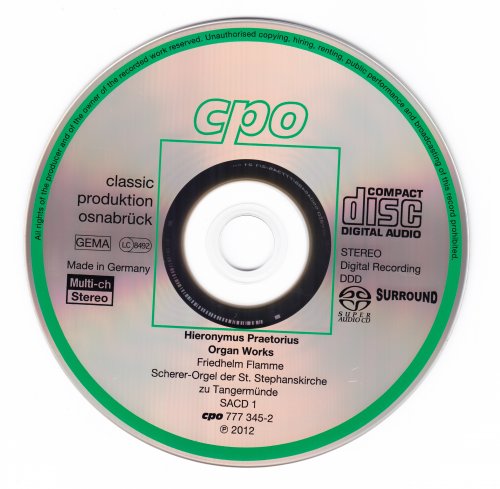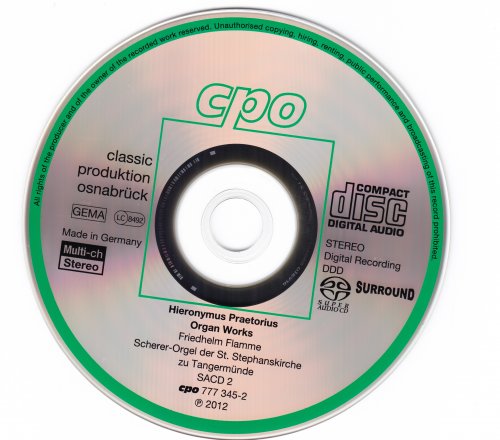
Friedhelm Flamme - Praetorius: Organ Works of the North German Baroque, Vol. 9 (2012) [SACD]
BAND/ARTIST: Friedhelm Flamme
- Title: Praetorius: Organ Works of the North German Baroque, Vol. 9
- Year Of Release: 2012
- Label: CPO
- Genre: Classical
- Quality: DSD64 image (*.iso) / 2.0, 5.1 (2,8 MHz/1 Bit)
- Total Time: 02:15:35
- Total Size: 7.48 GB
- WebSite: Album Preview
Tracklist:
CD 1
1. Magnificat primi toni (07:03)
2. Magnificat secundi toni (06:28)
3. Wenn mein Stündlein vorhanden ist (07:02)
4. Magnificat tertii toni (10:23)
5. Magnificat quarti toni (09:01)
6. Lucis Creator optime (04:52)
7. Veni Creator Spiritus (06:29)
8. Veni Redemptor Gentium (05:09)
9. Christ, unser Herr, zum Jordan kam (08:23)
CD 2
1. Magnificat quinti toni (10:17)
2. Magnificat sexti toni (08:14)
3. Kyrie summum (06:11)
4. Gloria in excelsis Deo / Et in terra summum (05:12)
5. Sanctus summum (02:24)
6. Agnus Dei (03:45)
7. Sequentia: Sancti Spiritus adsit nobis gratia (03:02)
8. In exitu Israel de Aegypto (Psalm 113) (02:40)
9. Magnificat germanice (03:25)
10. Magnificat septimi toni (14:46)
11. Magnificat octavi toni (11:30)
![Friedhelm Flamme - Praetorius: Organ Works of the North German Baroque, Vol. 9 (2012) [SACD]](https://www.dibpic.com/uploads/posts/2022-01/1642755057_back.jpg)


CD 1
1. Magnificat primi toni (07:03)
2. Magnificat secundi toni (06:28)
3. Wenn mein Stündlein vorhanden ist (07:02)
4. Magnificat tertii toni (10:23)
5. Magnificat quarti toni (09:01)
6. Lucis Creator optime (04:52)
7. Veni Creator Spiritus (06:29)
8. Veni Redemptor Gentium (05:09)
9. Christ, unser Herr, zum Jordan kam (08:23)
CD 2
1. Magnificat quinti toni (10:17)
2. Magnificat sexti toni (08:14)
3. Kyrie summum (06:11)
4. Gloria in excelsis Deo / Et in terra summum (05:12)
5. Sanctus summum (02:24)
6. Agnus Dei (03:45)
7. Sequentia: Sancti Spiritus adsit nobis gratia (03:02)
8. In exitu Israel de Aegypto (Psalm 113) (02:40)
9. Magnificat germanice (03:25)
10. Magnificat septimi toni (14:46)
11. Magnificat octavi toni (11:30)
Hieronymus Praetorius (1560–1629) is not to be confused with his far more famous but unrelated contemporary Michael Praetorius (the surname being a Latinization of the original German one, “Schulze”). Relatively little is known of his life. Born in Hamburg, he was the son of an organist named Jacob Praetorius (not to be confused with Hieronymus’s son of the same name, who was also an organist and composer). He was trained on that instrument, first by his father and then by Hinrich thor Molen in Hamburg in 1573, and then studied in Cologne under Albinus Walran (or Walraff); dates for the latter period are variously given as 1574–76 and 1577–78. After serving briefly as an organist in Erfurt from 1580 to 1582, he returned to his native Hamburg to assist his father, succeeding him as organist of the Lutheran Jacobikirche (Church of St. James) in 1586 and holding that post to the end of his life. A marriage produced seven children; three of his four sons also became organists. He appears to have traveled little, but he did meet Michael Praetorius and Hans Leo Hassler at an organ examination in Gröningen in 1596.
Most of the compositions of Hieronymus were published in a series of five volumes between 1616 and 1625; they include 102 motets and six parody Masses. (He also was the chief compiler of a collection of 88 four-part German chorale settings, the 1604 Melodeyen Gesangbuch, notable for being the first collection of German hymns to specify organ accompaniment to congregational singing.) Along with Michael Praetorius, Hassler, and Jacobus Gallus, Hieronymus was one of the key pioneers of the new Venetian polychoral style of composition in Germany. The eight organ settings of the Magnificat, one each in the canonical eight tones, that comprise most of the contents of this disc survive in the Visby Tablature, a manuscript assembled in 1611 by Berendt Petri (a pupil of the first Jacob Praetorius; his dates of birth and death are unknown) and preserved in the city of Visby on the Swedish island of Gotland; most of the 41 anonymous short pieces in that manuscript are now ascribed to Hieronymus as well. Of those, several have been selected for inclusion on this disc, as well as two chorale fantasias and one other Magnificat setting (preserved in the Clausthal-Zellerfeld Tablature, also dating from the early 1600s) also definitely known to be by Hieronymus. All of the eight Visby Magnificat settings follow the same basic pattern of setting “verses” or discrete compositional units, first in the tenor part, then the descant, and then the bass; three interject or append one or two additional verses with the indication “Vp 2 Clauier” (on two manuals), while one other setting adds a fugue. Each of these verses elaborates on the cantus firmus line in various ways, sometimes with strict counterpoint and at other times more freely.
Despite the employment of the new Venetian style, these pieces are also definitely anchored in older Renaissance dance forms, and are not as imaginative as those of Jan Sweelinck, featured on a recent MDG release that I reviewed in 35:3. However, they are important examples of early organ music in early 17th-century Germany, and this appears to be the first recording they have received. The performances (on the 1624 Scherer organ of St. Stephen’s Church in Tangermünde) are well done, and the SACD recorded sound brings out all facets of the organ clearly, though again it is not as impressive as on the aforementioned MDG disc of Sweelinck’s music. Most helpfully, each verse within each of the Magnificats has its own track, and the booklet notes provide both detailed specifications of the organ’s construction and precise indications of the registrations used in playing each verse. Duly recommended to all devotees of organ music before Buxtehude and Bach.
Most of the compositions of Hieronymus were published in a series of five volumes between 1616 and 1625; they include 102 motets and six parody Masses. (He also was the chief compiler of a collection of 88 four-part German chorale settings, the 1604 Melodeyen Gesangbuch, notable for being the first collection of German hymns to specify organ accompaniment to congregational singing.) Along with Michael Praetorius, Hassler, and Jacobus Gallus, Hieronymus was one of the key pioneers of the new Venetian polychoral style of composition in Germany. The eight organ settings of the Magnificat, one each in the canonical eight tones, that comprise most of the contents of this disc survive in the Visby Tablature, a manuscript assembled in 1611 by Berendt Petri (a pupil of the first Jacob Praetorius; his dates of birth and death are unknown) and preserved in the city of Visby on the Swedish island of Gotland; most of the 41 anonymous short pieces in that manuscript are now ascribed to Hieronymus as well. Of those, several have been selected for inclusion on this disc, as well as two chorale fantasias and one other Magnificat setting (preserved in the Clausthal-Zellerfeld Tablature, also dating from the early 1600s) also definitely known to be by Hieronymus. All of the eight Visby Magnificat settings follow the same basic pattern of setting “verses” or discrete compositional units, first in the tenor part, then the descant, and then the bass; three interject or append one or two additional verses with the indication “Vp 2 Clauier” (on two manuals), while one other setting adds a fugue. Each of these verses elaborates on the cantus firmus line in various ways, sometimes with strict counterpoint and at other times more freely.
Despite the employment of the new Venetian style, these pieces are also definitely anchored in older Renaissance dance forms, and are not as imaginative as those of Jan Sweelinck, featured on a recent MDG release that I reviewed in 35:3. However, they are important examples of early organ music in early 17th-century Germany, and this appears to be the first recording they have received. The performances (on the 1624 Scherer organ of St. Stephen’s Church in Tangermünde) are well done, and the SACD recorded sound brings out all facets of the organ clearly, though again it is not as impressive as on the aforementioned MDG disc of Sweelinck’s music. Most helpfully, each verse within each of the Magnificats has its own track, and the booklet notes provide both detailed specifications of the organ’s construction and precise indications of the registrations used in playing each verse. Duly recommended to all devotees of organ music before Buxtehude and Bach.
![Friedhelm Flamme - Praetorius: Organ Works of the North German Baroque, Vol. 9 (2012) [SACD]](https://www.dibpic.com/uploads/posts/2022-01/1642755057_back.jpg)


Download Link Isra.Cloud
Friedhelm Flamme - Praetorius: Organ Works of the North German Baroque, Vol. 9 (2012) part1.
Friedhelm Flamme - Praetorius: Organ Works of the North German Baroque, Vol. 9 (2012) part2.
Friedhelm Flamme - Praetorius: Organ Works of the North German Baroque, Vol. 9 (2012) part3.
Friedhelm Flamme - Praetorius: Organ Works of the North German Baroque, Vol. 9 (2012) part4.
My blog
Friedhelm Flamme - Praetorius: Organ Works of the North German Baroque, Vol. 9 (2012) part1.
Friedhelm Flamme - Praetorius: Organ Works of the North German Baroque, Vol. 9 (2012) part2.
Friedhelm Flamme - Praetorius: Organ Works of the North German Baroque, Vol. 9 (2012) part3.
Friedhelm Flamme - Praetorius: Organ Works of the North German Baroque, Vol. 9 (2012) part4.
My blog
As a ISRA.CLOUD's PREMIUM member you will have the following benefits:
- Unlimited high speed downloads
- Download directly without waiting time
- Unlimited parallel downloads
- Support for download accelerators
- No advertising
- Resume broken downloads


![Friedhelm Flamme - Praetorius: Organ Works of the North German Baroque, Vol. 9 (2012) [SACD]](https://www.dibpic.com/uploads/posts/2022-01/1642755061_cover.jpg)